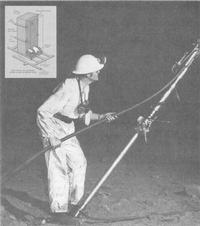


Chapter 9
I Introduction
II The Australian Chemical Industry
i Beginnings 1865-1919
ii Fertilisers
iii Raw materials from gasworks and coke ovens
iv The beginnings of industrial chemical research - in the sugar industry
v Explosives
III Pharmaceuticals
IV Chemists In Other Industries
V The Dawn Of Modern Chemical Industry - High Pressure Synthesis
VI The Growth Of Synthetic Chemicals - Concentration, Rationalisation And International Links
VII Australian Industrial Chemical Research Laboratories
VIII The Plastics Industry
IX The Paint Industry
X Acknowledgements
References
Index
Search
Help
Contact us

ICI Australia, CIL, ICI UK and AE&CI research laboratories continued to work on further perfection of AN systems. Bulk watergels -water slurries -had been pioneered by Cook and CIL ('Hydromex') and were developed by ICI R & D labs ('Molanal', 'Iregel' under license to Ireco) and adapted to new and demanding uses.
Just one of these developments might be recorded[49][50] because it is typical of the interaction between the mining and chemical industries and scientists. At Mt Isa Mines massive ore pillars -each some 1800 million cubic metres -had to be removed. To achieve this in a single operation, explosive had to be pumped from a central tunnel into hundreds of 30 m long boreholes arranged in sequences of vertical planes and converging in each place to the central tunnel (Fig. 11). The boreholes thus radiated from the tunnel, downwardly, horizontally and upwardly. Watergels were indicated because of residual water in some holes; the many holes running upwardly had to retain the explosive for the prolonged period of preparation of the blast. This could only be achieved by pumping the watergel upwardly and causing it to gel instantaneously. Mt Isa invited ICI Australia Research Lab to collaborate on the project. New chemistry was needed; new engineering to pump viscous explosives hundreds of metres underground; and new electronic detonators were invented by the ICI team to detonate the charges in quick-fire succession, at intervals of milliseconds, since a single blast would have damaged buildings (a chimney stack!) above ground. Preparation of the blast by Mt Isa engineers and of the explosives system by ICI took several years, cost about seven million dollars and 350 tonnes of explosives brought down a pillar 225 m high, 100 m wide and 80 m long; 1.3 million tonnes of rock in a single blast! It was just one event; it symbolised the third explosives revolution, the science industry interaction and the maturity to which the technology had grown in Australia.

ICI's watergel chemistry ('Molanal'), including the material used in this gigantic blast, had really reverted, at least semi-empirically, to the teaching of Bowden, Mulcahy, Vines and Yoffe (see pp 645-6) that air bubbles were a critical factor in sensitivity; aluminium particles enhanced their presence; crosslinking agents trapped them and attempts were even made to introduce them with plastic foams.
The last advances in the evolution, still progressing in the eighties, were emulsion explosives, aqueous solutions of oxidizing agents intimately dispersed in an oil matrix. DuPont introduced such bulk emulsions, (Tovex E') based, however, on a classified explosive, methylamine nitrate, and ICI developed a series of AN based emulsions, 'Powergels'. Evolution turned full cycle in the late seventies and eighties when AN watergels were packaged into tubes similar in appearance to traditional gelignite but based on paint fine aluminium, gas-bubble-sensitised blasting agents (ICI, Ireco) or methylamine nitrate (DuPont). Intimate contact, high density, improved waterproofing and suitability for both bulk and packaged explosives produced outstanding performance in the field. Emulsions also provided the ICI Australia team with the opportunity to make better and controlled use of the Bowden-Mulcahy (adiabatic compression) gas bubble effect discussed earlier. Using special surfactants they were able to incorporate gas and control and retain the gas bubble size. This led to the world's first gassed emulsion explosive 'Powergel 2510'.
Organisations in Australian Science at Work - A.E. & C.I.; I.C.I. Australia Ltd
People in Bright Sparcs - Bowden, F. P.; Mulcahy, M. F. R.; Vines, R. G.
 |
Australian Academy of Technological Sciences and Engineering |  |
© 1988 Print Edition pages 648 - 649, Online Edition 2000
Published by Australian Science and Technology Heritage Centre, using the Web Academic Resource Publisher
http://www.austehc.unimelb.edu.au/tia/614.html